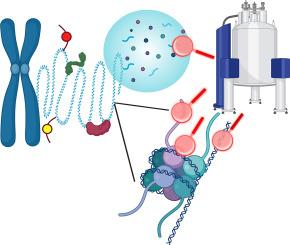Unveiling structural and dynamical features of chromatin using NMR spectroscopy
引用次数: 0
Abstract
Eukaryotic deoxyribonucleic acid (DNA) is wrapped around histone octamers (HOs) to form nucleosome core particles (NCPs), which in turn interact with linker DNA and linker histones to assemble chromatin fibers with more complex, high-order structures. The molecular properties of chromatin are dynamically regulated by several factors, such as post-translational modifications and effector proteins, to maintain genome stability. In the past two decades, high-resolution techniques have led to many breakthroughs in understanding the molecular mechanisms that govern chromatin regulation. Nuclear magnetic resonance (NMR) has emerged as one of the major techniques in this field, providing new insights into the nucleosomes and nucleosome-protein complexes in different states ranging from soluble form to condensed states. Solution-state NMR has proven valuable in elucidating the conformational dynamics and molecular interactions for histone N-terminal tails, histone core regions and DNA with the combination of specific isotopic labeling. Solid-state NMR, which is not constrained by the high molecular weights of complexes like nucleosomes, has been applied to capture the structural and dynamical characteristics of both flexible tails and rigid histone core regions in nucleosomes and their complexes with effector proteins. Furthermore, the combination of the two techniques allows tracking molecular properties of nucleosomes during phase separation processes, which potentially play essential roles in chromatin regulation. This review summarizes recent advances in NMR studies of chromatin structure and dynamics. It highlighted that NMR revealed unique molecular characteristics for nucleosomes that are often invisible experimentally by other techniques like cryogenic electron microscopy (cryo-EM) and X-ray diffraction (XRD). I envision that, with future efforts such as the development of NMR methods and optimization of sample production protocols, solution-state NMR and solid-state NMR will provide invaluable information to expand our understanding of chromatin activity and its regulatory processes.

利用核磁共振光谱揭示染色质的结构和动态特征
真核生物脱氧核糖核酸(DNA)缠绕在组蛋白八聚体(HO)上,形成核小体核心颗粒(NCP),而核小体核心颗粒又与连接子DNA和连接子组蛋白相互作用,形成具有更复杂、更高阶结构的染色质纤维。染色质的分子特性受多种因素(如翻译后修饰和效应蛋白)的动态调控,以保持基因组的稳定性。在过去二十年中,高分辨率技术在理解染色质调控的分子机制方面取得了许多突破性进展。核磁共振(NMR)已成为这一领域的主要技术之一,它为人们了解核小体和核小体蛋白复合物在从可溶态到凝聚态等不同状态下的情况提供了新的视角。事实证明,结合特定同位素标记,溶液态核磁共振在阐明组蛋白 N 端尾、组蛋白核心区和 DNA 的构象动力学和分子相互作用方面具有重要价值。固态核磁共振不受核小体等复合物高分子量的限制,可用于捕捉核小体及其与效应蛋白复合物中柔性尾部和刚性组蛋白核心区的结构和动力学特征。此外,这两种技术的结合还能跟踪核小体在相分离过程中的分子特性,这可能在染色质调控中发挥重要作用。本综述总结了核磁共振染色质结构和动力学研究的最新进展。它强调核磁共振揭示了核小体的独特分子特性,而这些特性往往是低温电子显微镜(cryo-EM)和 X 射线衍射(XRD)等其他技术在实验中看不到的。我设想,随着核磁共振方法的发展和样品制作方案的优化等未来工作的开展,溶液态核磁共振和固态核磁共振将为拓展我们对染色质活动及其调控过程的理解提供宝贵的信息。
本文章由计算机程序翻译,如有差异,请以英文原文为准。
求助全文
约1分钟内获得全文
求助全文
来源期刊

Magnetic Resonance Letters
Analytical Chemistry, Spectroscopy, Radiology and Imaging, Biochemistry, Genetics and Molecular Biology (General)
自引率
0.00%
发文量
0
 求助内容:
求助内容: 应助结果提醒方式:
应助结果提醒方式:


